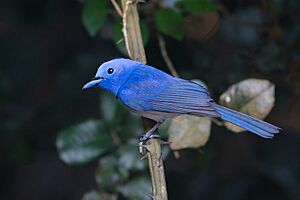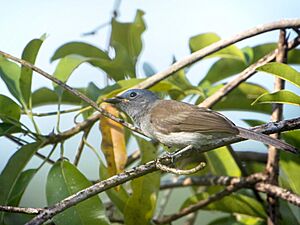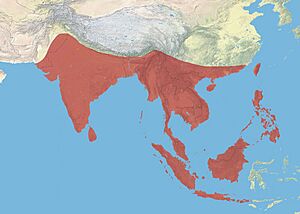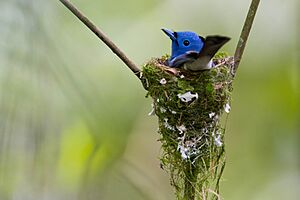Black-naped monarch facts for kids
Quick facts for kids Black-naped monarch |
|
|---|---|
 |
|
| A male (H. a. montana) from Kaeng Krachan in Thailand | |
 |
|
| H. a. montana female | |
| Conservation status | |
| Scientific classification | |
| Genus: |
Hypothymis
|
| Species: |
azurea
|
| Subspecies | |
|
See text |
|
 |
|
| approximate distribution | |
| Synonyms | |
|
|
The black-naped monarch (Hypothymis azurea) is a beautiful, quick bird found in southern and south-eastern Asia. It's part of the monarch flycatcher family. These birds are known for their bright blue feathers.
Males and females look different, which is called sexual dimorphism. The male has a special black patch on the back of its head and a thin black "necklace." Females are less colorful, with olive-brown wings and no black marks on their heads. Their calls sound a bit like the Asian paradise flycatcher. In tropical forests, these birds often join mixed-species foraging flocks, which are groups of different bird species hunting for food together.
Contents
About the Black-Naped Monarch
The black-naped monarch was first described in 1779 by a French scientist named Georges-Louis Leclerc, Comte de Buffon. Later, in 1783, another scientist, Pieter Boddaert, gave it its scientific name, Muscicapa azurea. The name azurea comes from a word meaning "azure-blue," which describes its color.
Today, this bird is placed in the genus Hypothymis. The name Hypothymis comes from an ancient Greek word for an unknown bird.
Different Types of Black-Naped Monarchs
There are many different types of black-naped monarchs, called subspecies. These subspecies are slightly different depending on where they live. Here are a few examples:
- H. a. styani: Found from India to China and Vietnam. Males of this type have a whitish belly.
- H. a. ceylonensis: Found in Sri Lanka. Males of this type do not have the black patch on their head or the black necklace.
- H. a. tytleri: Found in the Andaman Islands. Males of this type have blue-grey underparts.
- H. a. azurea: This is the type found in the Philippines.
What They Look Like
Adult male black-naped monarchs are about 16 centimeters (about 6 inches) long. They are mostly pale blue, with a whitish lower belly. They have a black patch on the back of their neck and a thin black band around their throat.
Female black-naped monarchs are not as bright. They don't have the black marks. Their wings and back are more grey-brown. However, the exact colors and markings can be a bit different depending on where the birds live. For example, males in Sri Lanka might not have the black necklace.
Where They Live and Their Home
The black-naped monarch lives in warm, tropical parts of southern Asia. You can find them from Iran and Sri Lanka all the way east to Indonesia and the Philippines. These birds usually live in thick forests and other places with lots of trees.
Their call is a short, sharp sound that sounds like skrip.
How They Live
Black-naped monarchs have short legs. They often sit very straight on branches, like a shrike. They are insectivorous, meaning they eat insects. They often catch insects while flying, which is called "flycatching." When they are worried or alert, the feathers on the back of their neck stand up, making a pointed crest.
These birds often join groups of different bird species that hunt for food together. They are very active in the lower parts of the forest canopy. Studies have shown that they tend to move away from areas where there is a lot of human activity.
Even though they mostly stay in one place, they might move around a bit during different seasons. In India, they usually breed from March to August. They build a neat cup-shaped nest in the fork of a tree. The female builds the nest, and the male guards it. They use spider webs and even some types of fungi to line the nest. The fungi might help protect the baby birds from sickness.
A female usually lays three eggs. Both parents take turns sitting on the eggs to keep them warm. The eggs hatch after about 12 days. Both parents also help feed the young birds.
Images for kids






